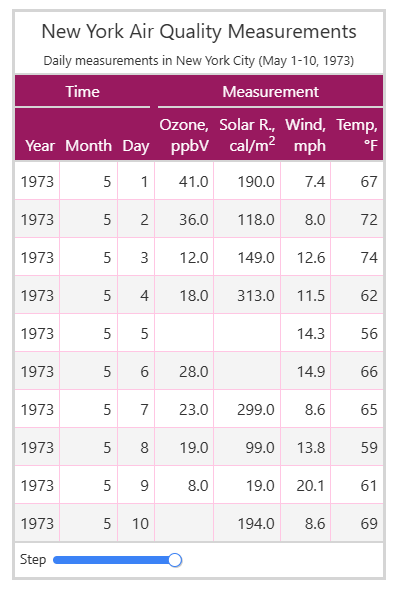import marimo
__generated_with = "0.14.8"
app = marimo.App(width="medium")
@app.cell
def _():
import marimo as mo
return (mo,)
@app.cell
def _():
import copy
import inspect
from functools import wraps
from typing import Callable, Self
import pandas as pd
from great_tables import GT, html
from great_tables.data import airquality
return Callable, GT, Self, airquality, copy, html, inspect, wraps
@app.cell
def _(Callable, GT, Self, copy, html, inspect, wraps):
def get_allowed_member_names() -> list[str]:
"""
Manually constructing the list —
it would be great if Great Tables exposed the available method names.
"""
return [
"fmt",
"fmt_number",
"fmt_integer",
"fmt_percent",
"fmt_scientific",
"fmt_currency",
"fmt_bytes",
"fmt_roman",
"fmt_date",
"fmt_time",
"fmt_datetime",
"fmt_markdown",
"fmt_image",
"fmt_icon",
"fmt_flag",
"fmt_units",
"fmt_nanoplot",
"data_color",
"sub_missing",
"sub_zero",
"opt_stylize",
"opt_align_table_header",
"opt_all_caps",
"opt_footnote_marks",
"opt_row_striping",
"opt_vertical_padding",
"opt_horizontal_padding",
"opt_table_outline",
"opt_table_font",
"cols_align",
"cols_width",
"cols_label",
"cols_move",
"cols_move_to_start",
"cols_move_to_end",
"cols_hide",
"cols_unhide",
"tab_header",
"tab_source_note",
"tab_spanner",
"tab_stubhead",
"tab_style",
"tab_options",
"row_group_order",
"tab_stub",
"with_id",
"with_locale",
"save",
"show",
"as_raw_html",
"write_raw_html",
"as_latex",
"pipe",
]
def lazify(cls: GT) -> GT:
def add_to_pipeline(func: Callable[..., GT]) -> callable:
@wraps(func)
def wrapper(self, *args, **kwargs):
def inner(self):
return func(self, *args, **kwargs)
# container for storing callable objects
self._pipeline.append(inner)
return self
wrapper.__signature__ = inspect.signature(func)
return wrapper
for member_name in get_allowed_member_names():
setattr(
cls, member_name, add_to_pipeline(getattr(GT, member_name))
)
return cls
@lazify
class WigGT:
def __init__(self, *args, widget, **kwargs):
self._args = args
self._widget = widget
self._kwargs = kwargs
self.set_to_init()
@property
def tables(self) -> list[GT]:
return list(self._tables) # return a new list
def _widgetify(self, obj: GT) -> GT:
return obj.tab_source_note(html(self._widget))
def collect(self) -> Self:
if not self._is_collect:
new_obj = self._tables[0] # don't use self._wtables[0]
for f in self._pipeline:
new_obj = f(self=copy.copy(new_obj))
self._tables.append(new_obj)
self._wtables.append(self._widgetify(new_obj))
self._is_collect = True
return self
def _repr_html_(self) -> str:
try:
obj = self._wtables[self._widget.value]
except IndexError:
obj = self._wtables[-1]
if hasattr(obj, "_display_"):
render_method = "_display_"
elif hasattr(obj, "_repr_html_"):
render_method = "_repr_html_"
elif hasattr(obj, "_mime_"):
render_method = "_mime_"
else:
raise AttributeError(
"The object does not have a valid render method."
)
return getattr(obj, render_method)() # remember to invoke
def set_to_init(self) -> None:
if not getattr(self, "_pipeline", None):
self._pipeline: list[callable] = []
else:
self._pipeline.clear()
if not getattr(self, "_tables", None):
self._tables = []
else:
self._tables.clear()
if not getattr(self, "_wtables", None):
self._wtables = []
else:
self._wtables.clear()
obj = self._make_gt()
self._tables.append(obj)
self._wtables.append(self._widgetify(obj))
self._is_collect = False
def _make_gt(self) -> GT:
return GT(*self._args, **self._kwargs)
return (WigGT,)
@app.cell
def _(mo):
time_widget = mo.ui.slider(start=0, stop=6, step=1, value=0, label="Step")
time_widget
return (time_widget,)
@app.cell
def _(WigGT, airquality, html, time_widget):
# The lazy_wig_gt object is not interactive until collect() is called.
lazy_wig_gt = (
WigGT(airquality.head(10).assign(Year=1973), widget=time_widget)
.opt_stylize(color="pink", style=2)
.tab_header(
title="New York Air Quality Measurements",
subtitle="Daily measurements in New York City (May 1-10, 1973)",
)
.tab_spanner(label="Time", columns=["Year", "Month", "Day"])
.tab_spanner(
label="Measurement", columns=["Ozone", "Solar_R", "Wind", "Temp"]
)
.cols_move_to_start(columns=["Year", "Month", "Day"])
.cols_label(
Ozone=html("Ozone,<br>ppbV"),
Solar_R=html("Solar R.,<br>cal/m<sup>2</sup>"),
Wind=html("Wind,<br>mph"),
Temp=html("Temp,<br>°F"),
)
)
lazy_wig_gt
return (lazy_wig_gt,)
@app.cell
def _(lazy_wig_gt):
# The wig_gt object is now interactive
wig_gt = lazy_wig_gt.collect()
wig_gt
return (wig_gt,)
@app.cell
def _(wig_gt):
# retrieve all `gt` tables
wig_gt.tables
return
if __name__ == "__main__":
app.run()
